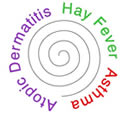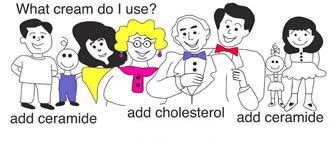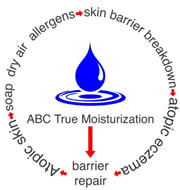|
|||||
|
What is Atopic Dermatitis? Click here to learn more about Atopic Dermatitis Atopic Dermatitis
Here is a simple way to understand the concept of Atopic Dermatitis. For simplicity, think of asthma as affecting three sites: in the lungs, you get wheezing, in the sinuses, you get hay fever, and in the skin, you get eczema, also known as "atopic dermatitis". Though many skin conditions are linked to dry and sensitive skin, dry and sensitive skin in a child is often associated with the allergic triad of atopic dermatitis, hay fever, and asthma.
Findings in Atopic Dermatitis You see the triad of: Atopic Dermatitis, Asthma, and Hay Fever, Atopic dermatitis affects 13% of children and 2% of adults. An extra fragile, easily damaged skin barrier, high immunoglobulin E levels, and an extremely sensitive allergic immune system result in extreme itch and a vicious itch-scratch cycle. Patients react to foods, mites, dust, staph aureus, emotional stress, and many topical allergenic items such as wool, animals, soaps, detergents, pollens, molds, and perfumes. Atopic (eczema-prone) patients are more susceptible to viral, yeast, and bacterial infections and get warts, molluscum, herpes, impetigo, and diaper rashes. Nighttime itch robs these children of sleep and both the children and the parents suffer from chronic sleep deprivation.
Medical research shows that senior age patients mostly lose cholesterol lipids, while atopic patients and younger adults mostly lose ceramide lipids. These facts help us realize that even though cholesterol and ceramides are both needed, the senior age patients will actually benefit more from cholesterol lipid replacement therapy, while younger and atopic patients will benefit more from ceramide lipid replacement moisturization therapy.
Atopics Need Daily Moisturization The basic skin care shortcoming for most atopic children is a lack of correct dry skin moisturization. From the beginning, parents need to learn the importance of true moisturizing techniques and skin barrier based skin care. |
| DOCTORS, SALONS, SPAS, ESTHETICIANS, RETAIL STORES, SKIN CARE CONSULTANTS... Offer your customers the most innovative dry skin care line on the market! |
| Home | Account Login | Contact Us | Request booklet | Site Map | |
| © 2011, True Moisture LLC. All Rights Reserved | |||||





